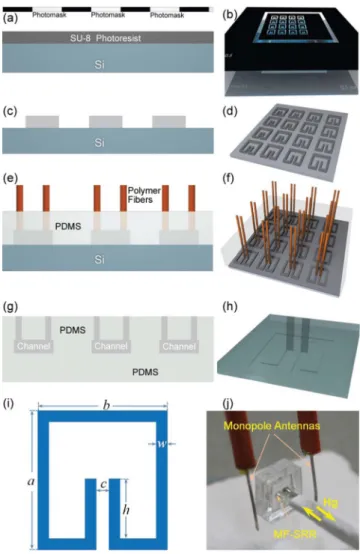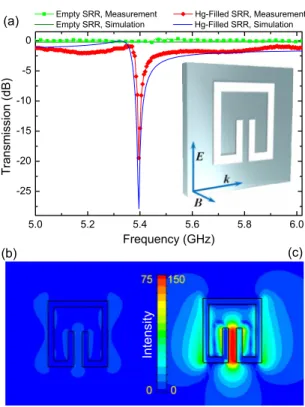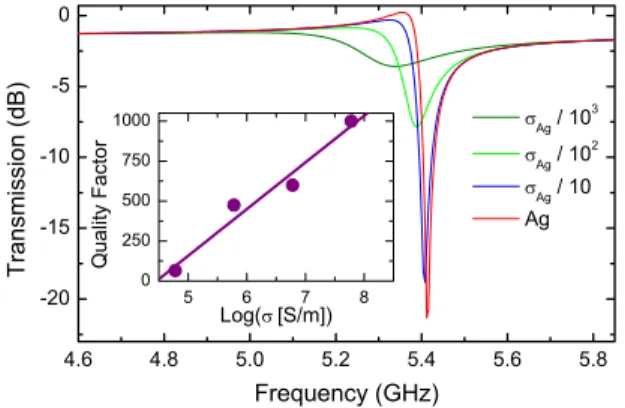Microfluidics for reconfigurable electromagnetic metamaterials
T. Serkan Kasirga, Y. Nuri Ertas, and Mehmet Bayindir
Citation: Appl. Phys. Lett. 95, 214102 (2009); View online: https://doi.org/10.1063/1.3268448
View Table of Contents: http://aip.scitation.org/toc/apl/95/21
Published by the American Institute of Physics
Articles you may be interested in
Structural tunability in metamaterials
Applied Physics Letters 95, 084105 (2009); 10.1063/1.3211920
Electrically tunable negative permeability metamaterials based on nematic liquid crystals
Applied Physics Letters 90, 011112 (2007); 10.1063/1.2430485
Magnetic control of negative permeability metamaterials based on liquid crystals
Applied Physics Letters 92, 193104 (2008); 10.1063/1.2926678
Tunable optical negative-index metamaterials employing anisotropic liquid crystals
Applied Physics Letters 91, 143122 (2007); 10.1063/1.2795345
A reconfigurable liquid metal antenna driven by electrochemically controlled capillarity
Journal of Applied Physics 117, 194901 (2015); 10.1063/1.4919605
Liquid crystal based nonlinear fishnet metamaterials
Microfluidics for reconfigurable electromagnetic metamaterials
T. Serkan Kasirga,1,2Y. Nuri Ertas,1and Mehmet Bayindir1,2,a兲1UNAM-Institute of Materials Science and Nanotechnology, Bilkent University, 06800 Ankara, Turkey 2Department of Physics, Bilkent University, 06800 Ankara, Turkey
共Received 7 September 2009; accepted 3 November 2009; published online 25 November 2009兲 We propose microfluidics as a useful platform for reconfigurable electromagnetic metamaterials. Microfluidic split-ring resonators共MF-SRRs兲 are fabricated inside a flexible elastomeric material by employing rapid prototyping. The transmission measurements performed for mercury-injected MF-SRR exhibits sharp magnetic resonances at microwave wavelengths. We further calculate transmission properties of the MF-SRR array and the effect of electrical conductivity of the liquid inside the channel on the magnetic resonance. The measured results agree well with numerical calculations. Our proposal may open up directions toward switchable metamaterials and reconfigurable devices such as filters, switches, and resonators. © 2009 American Institute of
Physics. 关doi:10.1063/1.3268448兴
Left-handed metamaterials 共LHMs兲 having periodically arranged split-ring resonators 共SRRs兲 共Refs. 1–3兲 and thin wires4offer vast variety of applications due to their peculiar electromagnetic共EM兲 properties.5–8Recently, tunable LHM components have attracted great interest since some of the potential applications of LHM require dynamical control of the EM properties.9–18 Because, the frequency region with negative permeability 共−兲 is narrow compared to negative permittivity共−,兲 region, left-handed passband frequency re-gion mostly depend on the magnetic plasma frequency共m兲 of the SRR lattice.1,2Thus, being able to tunemwill lead to dynamically tunable metamaterials. The magnetic resonance frequency of SRRs can be tuned by various mechanisms such as capacitor loaded SRRs,9,10,12,13 photoconductive semiconductors,11nematic liquid crystals,14,18 and ferroelec-tric loaded split rings.16 The electrical resonance of SRR structures can also be tuned in order to modulate optical properties of devices.19
In this letter, we propose and demonstrate a new plat-form for metamaterial components based on microfluidics. Microfluidic split-ring resonator 共MF-SRR兲 is fabricated in an elastomeric material关poly共dimethylsiloxane兲 共PDMS兲兴 by employing rapid prototyping. Transmission measurements are performed for a mercury-injected single MF-SRR, and a magnetic resonance is observed at microwave frequencies. We further investigate the transmission properties of an MF-SRR array and the effect of the electrical conductivity of injected liquid inside MF channels on the magnetic reso-nance by using finite difference time domain共FDTD兲 simu-lations.
We use rapid prototyping,20which is a common method to fabricate devices in microfluidics,21 to fabricate MF-SRR channels in PDMS polymer as shown in Figs. 1共a兲–1共h兲. Single-SRR geometry6is preferred due to the ease of metal-lic liquid injection. In this geometry, m can be tuned by changing the structural parameters c and h 关Fig.1共i兲兴. Two monopole antennas are used to measure the transmission properties of MF-SRR in free space 关Fig. 1共j兲兴. First, we measured the EM response of a single MF-SRR with and without mercury injection through the microfluidic channels.
a兲Electronic mail: bayindir@nano.org.tr.
FIG. 1.共Color online兲 Fabrication steps of MF-SRRs. 关共a兲 and 共b兲兴 MF-SRR patterns on SU-8 50 photoresist, by using photolithography.关共c兲 and 共d兲兴 Defining positive relief of MF-SRR array on Si wafer.关共e兲 and 共f兲兴 Placing polymer fibers to define in and out channels. Casting PDMS onto Si wafer, then curing the polymer at 65 ° C and peeling cured PDMS from the wafer. Polymer fibers are obtained from a macroscopic preform by thermal draw-ing in a custom-build fiber tower.共g兲 Sealing of SRRs with bottom PDMS slab after exposing both surfaces to oxygen plasma.共h兲 A single MF-SRR cut from the MF-SRR array is ready for metal injection.共i兲 Schematic draw-ing of a MF-SRR with parameters a = 5.5 mm, b = 5.0 mm, h = 2.4 mm, c = 0.7 mm, and w = 0.5 mm.共j兲 Microwave transmission measurement setup with two monopole antennas.
APPLIED PHYSICS LETTERS 95, 214102共2009兲
Figure 2共a兲displays the measured and calculated responses of empty and mercury-filled SRR. Mercury-filled MF-SRR exhibits a sharp magnetic resonance at 5.41 GHz, while empty MF-SRR the spectra shows no resonances, as ex-pected. The FDTD simulation result agrees well with the measurements. In simulations, the conductivity of mercury is taken Hg= 106 S/m. Since the inlet and outlet channels are perpendicular to MF-SRR plane, they do not affect the reso-nance frequencym.
Appearance of the magnetic resonance in transmission spectrum after metal injection into MF-SRR channel indi-cates the negative permeability which allows to tune EM properties dynamically. The switching time between on 共−兲 and off 共+兲 modes of MF-SRR is order of seconds and limited by the pumping speed of mercury to the channel. It is not observed any significant change in the magnetic resonance frequency and deformation of channels after re-peating the experiments several times. It is important to note that switching of magnetic resonance frequency is not pos-sible in previously proposed tunable SRR structures; in these studies frequency can only be tuned within a narrow fre-quency range.
Figures 2共b兲 and2共c兲show calculated electric field in-tensity distribution in a single MF-SRR at off- and on-resonance frequencies, respectively. While the field intensity is very weak at the split region of SRR at off-resonance frequency 共= 7.0 GHz兲, the field intensity increased and mostly concentrated at the split region at on-resonance fre-quency 共= 5.41 GHz兲.
The effective permeability of an MF-SRR array can be estimated from following expression:1
eff共兲 =⬘+ i⬙= 1 −
F2
2−
m
2+ i⌫, 共1兲
whereis the frequency of incident radiation and F = 0.43 is the fractional area of the unit cell occupied by the interior of a MF-SRR and⌫=0.12 GHz is the dissipation factor. Figure 3 displays the calculated real part of effusing Eq. 共1兲 and standard S-parameter retrieval method.22It can be seen that the negative magnetic response region extends up to 6 GHz. We also calculated the transmission properties of mercury-filled and empty MF-SRR array 共Fig. 4兲. While empty MF-SRR array does not show any resonances, mercury-filled MF-SRR array exhibits a stop band region centered at 5.2 GHz. The SRR array is embedded inside PDMS polymer. The simulated result indicates the possibility of obtaining −and +media, and switching between each others in flexible substrates.
The MF-SRR can also be filled with by any other con-ducting liquids such as colloidal silver solution containing nanoparticles. Since conductivity of metallic liquid is critical for obtaining magnetic resonances in MF-SRR structures, we investigated the effect of conductivity of the liquid used in MF-SRR on the magnetic resonancem. As shown in Fig.5, the magnetic resonance diminishes significantly as the con-ductivity of the liquid decreases. The quality factor Q =m/⌬ of magnetic resonance decreases rapidly with de-creasing conductivity共Fig.5inset兲.
FIG. 2. 共Color online兲 共a兲 Measured and calculated transmission spectrum of a single MF-SRR before and after metal injection. A magnetic resonance exists at= 5.41 GHz. The inset shows orientation of MF-SRR structure. Calculated electric field intensity at 共b兲 off-resonance frequency = 7.0 GHz and共c兲 on-resonance frequency= 5.41 GHz.
FIG. 3. 共Color online兲 Calculated real part of effective permeability of mercury-filled MF-SRR medium as a function of normalized frequency by using Eq.共1兲and S-parameter retrieval procedure.
FIG. 4. 共Color online兲 Calculated transmission spectrum of mercury-filled MF-SRR medium and empty MF-SRR with periods ax= 6.2 mm, ay
= 6.7 mm, and az= 5.0 mm. A negative permeability region is centered
around 5.2 GHz. The inset shows schematic drawing of mercury-filled MF-SRR medium. E-field polarization is along +y direction.
In the present work, we reported the possibility of achieving reconfigurable metamaterial components in flex-ible polymer substrates. The negative permeability region can be tuned by adding another microfluidic channel in the split region of MF-SRR. By injecting liquids with different permittivity and permeabilities inside this channel one can modify the capacitance of the MF-SRR, consequently the magnetic resonance frequency can be tuned.23 Combining negative permitivity共−兲 with negative permeability 共−兲 it should be possible to obtain reconfigurable MF-LHM. Thus, with the ability of microfluidic metamaterials it is possible to realize switchable EM medium, i.e., switching left-handed medium to right-hanged medium or vice versa. In addition, MF-SRR may be useful platform for construction of recon-figurable devices such as filters, switches, and resonators.
This work is supported by TUBITAK under the Grant No. 106G090. MB acknowledges support from the Turkish Academy of Sciences Distinguished Young Scientist Award 共TUBA GEBIP兲. This work was performed at UNAM-Institute of Materials Science and Nanotechnology supported by the State Planning Organization of Turkey through the
National Nanotechnology Research Center Project. We thank H. Caglayan and S. Cakmakyapan from Ozbay Research Group for their help in microwave measurements.
1J. B. Pendry, A. J. Holden, D. J. Robbins, and W. J. Stewart,IEEE Trans.
Microwave Theory Tech. 47, 2075共1999兲.
2D. R. Smith, W. J. Padilla, D. C. Vier, S. C. Nemat-Nasser, and S. Schultz,
Phys. Rev. Lett. 84, 4184共2000兲.
3M. Bayindir, K. Aydin, E. Ozbay, P. Markos, and C. M. Soukoulis,Appl.
Phys. Lett. 81, 120共2002兲.
4J. B. Pendry, A. J. Holden, W. J. Stewart, and I. Youngs,Phys. Rev. Lett.
76, 4773共1996兲.
5D. R. Smith, J. B. Pendry, and M. C. K. Wiltshire, Science 305, 788
共2004兲.
6D. Schurig, J. J. Mock, B. J. Justice, S. A. Cummer, J. B. Pendry, A. F.
Starr, and D. R. Smith,Science 314, 977共2006兲.
7V. M. Shalaev,Nat. Photonics 1, 41共2006兲.
8R. Marques, F. Martin, and M. Sorolla, Metamaterials with Negative Pa-rameters: Theory, Design and Microwave Applications共Wiley, New
Jer-sey, 2008兲.
9I. Gil, J. Bonache, J. Garcia-Garcia, and F. Martin,IEEE Trans.
Micro-wave Theory Tech. 54, 2665共2006兲.
10I. V. Shadrivov, S. K. Morisson, and Y. S. Kivshar,Opt. Express 14, 9344
共2006兲.
11A. Degiron, J. J. Mock, and D. R. Smith,Opt. Express 15, 1115共2007兲. 12K. Aydin and E. Ozbay,J. Appl. Phys. 101, 024911共2007兲.
13D. Wang, L. Ran, H. Chen, M. Mu, J. A. Kong, and B. Wu,Appl. Phys.
Lett. 91, 164101共2007兲.
14Q. Zhao, L. Kang, B. Du, B. Li, J. Zhou, H. Tang, X. Liang, and B. Zhang,
Appl. Phys. Lett. 90, 011112共2007兲.
15Q. Zhao, B. Du, L. Kang, H. Zhao, B. Li, X. Zhang, J. Zhou, L. Li, and Y.
Meng,Appl. Phys. Lett. 92, 051106共2008兲.
16T. H. Hand and S. A. Cummer,J. Appl. Phys. 103, 066105共2008兲. 17L. Kang, Q. Zhao, H. Zhao, and J. Zhou,Opt. Express 16, 8825共2008兲. 18F. Zhang, Q. Zhao, L. Kang, D. P. Gaillot, X. Zhao, J. Zhou, and S.
Lippens,Appl. Phys. Lett. 92, 193104共2008兲.
19H.-T. Chen, W. J. Padilla, J. M. O. Zide, A. C. Gossard, A. J. Taylor, and
R. D. Averitt,Nature共London兲 444, 597共2006兲.
20D. C. Duffy, J. C. McDonald, O. J. A. Schueller, and G. M. Whitesides,
Anal. Chem. 70, 4974共1998兲.
21N.-T. Nguyen and S. T. Wereley, Fundamentals and Applications of Mi-crofluidics, 2nd ed.共Artech House, Boston, 2006兲.
22D. R. Smith, D. C. Vier, Th. Koschny, and C. M. Soukoulis,Phys. Rev. E
71, 036617共2005兲.
23T. S. Kasirga and M. Bayindir共unpublished兲.
FIG. 5.共Color online兲 Calculated transmission spectrum of a MF-SRR as a function of electrical conductivity,, of liquid injected into the channels. Inset shows the effect of conductivity of the fluid inside the MF-SRR on the quality factor of the MF-SRR resonance.


